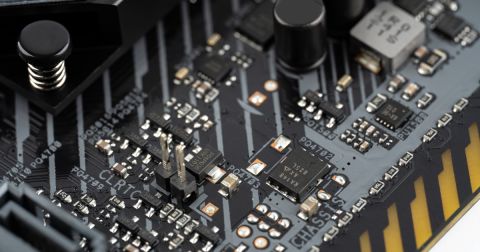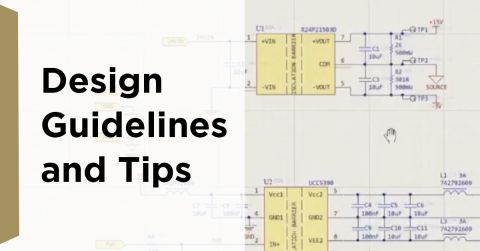When Do PCB Power Plane Resonances Occur?

By now, designers should be aware of some important behavior involved in power delivery to components in a PCB, particularly for digital components. All digital components produce and manipulate wideband signals, where the frequency content theoretically extends up to infinite frequency. As such, some radiation may propagate through your PCB, leading to resonant behavior that is not observed on the power rail.
This behavior is better known as power plane resonance. Whenever a power/ground plane pair is excited with a current pulse, that pulse emits some electromagnetic radiation, and that radiation can excite structural resonances at specific frequencies. Which frequencies will excite strong resonances depends on the dielectric thickness of the layer separating the plane pair, as well as the overall cavity size of the PCB. To see why this is important, you only have to look at the PDN impedance spectrum.
When Does a Power Plane Resonate?
The most important elements in your PDN are your power and ground plane pair. All power/ground plane pairs will have a set of resonances that can be excited by electromagnetic radiation. Such radiation arises whenever power is being pulled into the PDN. Remember, the plane pair in a PDN is like a big capacitor; when excited with a current pulse (from a digital signal) or a harmonic wave (from an analog signal), an electromagnetic disturbance develops between the power and ground planes. This disturbance can begin propagating between the planes, just like a large excited slot antenna. As electromagnetic waves propagate in the PDN, they can set up resonances and anti-resonances as different wavefronts interfere with each other.
These resonances happen at specific frequencies, sometimes called resonant frequencies or eigenfrequencies. The various frequencies involved can be calculated by treating the plane pair as an open cavity, better known as a waveguide. At certain frequencies, electromagnetic waves traveling in the plane pair waveguide will resonate, producing peaks and valleys in the PDN impedance spectrum.

Calculating Plane Resonant Frequencies
Unfortunately, you can’t easily calculate the resonant frequencies in a PDN exactly, you would need to do it with an electromagnetic field solver. This is because the PDN can have a complex structure, with multiple vias and conductors placed around the design. The plane region could also have a very odd shape that would not be easily solvable by hand.
Luckily, you don’t have to solve Maxwell’s equations or its corresponding wave equation yourself; the general solution to the wave equation in a cavity or waveguide is well-known and can be used to estimate a set of possible resonant frequencies. For our arrangement above, we would have the following formula for the eigenfrequencies of the plane pair waveguide:

These values would index successive resonances in sine and cosine eignefunctions. In the above example box, k would take any integer and correspond to a sine function with eigenvalue (kπ/H), while i and j would be any integer for cosine functions with eigenvalues (iπ/L) and (jπ/W), respectively.
How Many Resonances?
Theoretically, there is an infinite set of possible frequencies, and these are indexed by the set of integers (i, j, k). From this formula, we can use some estimates to generate a set of tables defining the waveguide’s resonant frequencies. To do this, we typically look at k = 0 for the height direction.
Why worry about k = 0? This is because, for the (0, 0, 1) resonance, the resonant frequencies corresponding to the vertical direction are hundreds of GHz. Just as an example, for an 8 mil thick dielectric with Dk = 4, the lowest order vertical resonance (k = 1) is 375 GHz. It is the lateral resonances that dominate as these resonances can appear around 1 GHz. This is one reason why PDNs with strong high frequency noise emissions can emit strongly from the board edges; they are emitting strongly due to resonant excitation in the power/ground plane pair structure as waves travel towards the edges of the circuit board.
Example PDN Impedance Spectra
When we look at a measured PDN impedance spectrum, resonances and antiresonances can be clearly identified in the GHz range. An set of example impedance spectra showing the structural resonances due to the power/ground plane pair arrangement is shown below. These resonances are shown for a plane pair with various dielectric thicknesses.

The image above shows how structural resonances and the overall impedance curve are affected by the thickness of the dielectric. As the dielectric gets thinner, we would expect the plane capacitance to increase, thus the overall impedance curve drops down and the impedance minimum (around 100 MHz) moves to lower frequencies. However, we see that the structural resonances are effectively unchanged. This is our cue that the above resonances are all k = 0 resonances, just as we would expect.
However, why are the resonant peaks smaller? This is because, as the thickness is decreased, the loss in the plane pair cavity increases, which dampens traveling waves and reduces the intensity of the electromagnetic field during resonance. This should illustrate the benefits of high Dk laminates. When used in PDN engineering applications, you want the highest Dk value possible to reach low impedance and to dampen resonance.
When one of these resonances is excited by a broadband signal or a harmonic signal, what is the effect on generated EMI? Since we are looking at PDN impedance in the above plot, I think it's important to remember how push-pull buffers work in modern ICs.
- A buffer in a high-speed component is sourcing a pulse of current at a specific voltage.
- That current pulse can excite a transient response on the PDN, and the impedance of the PDN structure will generate a corresponding ripple observed on the power rails.
- At maximum impedance, you will have maximum voltage rippling on that rail. Together with the current, the two will emit electromagnetic waves within the PDN structure.
- Emitted radiation can travel around the board and eventually exit through the board edge.
Are All Plane Resonances At GHz Frequencies?
The simple answer is "No". Of course in the above example data, we see these resonances start to appear around 800-900 MHz, but that does not mean every board will only exhibit power plane resonances only at these frequencies. Just as an example, circuit resonances can be modified by the presence of parasitics, something that is well-known in switching regulators. In the circuit view, the parasitics exist in series and/or parallel with the real circuit elements, so they modify the circuit impedance (or transfer function), and thus we would expect they would modify any resonance.
When talking specifically about structural resonances, we have to look at the wave perspective to better understand what is going on. In this perspective, feedback between wave propagation in the structure coexists with wave generation by circuit elements. When these groups of waves constructively interfere in the structure surrounding the circuit, you would have a resonance occur in that structure with strong electric and magnetic fields existing around the circuit. At certain frequencies, we would also expect destructive interference, leading to very weak fields in the structure. This partially explaines the alternating maximum and minimum peaks in the above graphs.
Simulating Power Plane Resonances
If you wanted to try and simulate power plane resonances, you can’t realistically do it with SPICE simulations unless you write a specific model that accounts for propagation and reflection of an electromagnetic wave. One would essentially need to write all the important field solver results into a SPICE subcircuit and attach this to a PDN “component” as it were. Unless you’re a SPICE expert, you’re out of luck on this front.
There is one interesting IEEE paper from 2001 that provides a SPICE model for lumped element circuits, just like you might do in SPICE to simulate a transmission line. The model basically lumps RLC elements into “cells” that have their own resonance and coupling, creating a large set of possible resonances to be observed in the resulting PDN impedance spectrum. This type of lumped element model and a link to this paper can be found below.

These lumped element models don’t exactly capture the true nature of wave propagation and essentially model the PDN as a big group of transmission lines in 3D. The whole point of this is to attempt to account for propagation and reflection, which would produce plane pair resonances at specific frequencies. If this system were simply prepared as a basic RLC circuit, the results would show a very high number of poles in the network’s transfer function; SPICE results would actually show the network resonating at the pole frequencies.
For this reason, electromagnetic field simulations for the PDN are needed. You can do these simulations with your Altium Designer® PCB layout by exporting your design into an Ansys field solver format using the EDB Exporter extension. When you’ve finished your design, and you’re ready to release files to your manufacturer, the Altium 365™ platform makes it easy to collaborate and share your projects.
We have only scratched the surface of what’s possible with Altium Designer on Altium 365. Start your free trial of Altium Designer + Altium 365 today.











